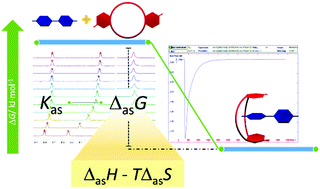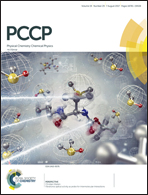Energetics and the molecular structure of an ion-paired supramolecular system in water†
Abstract
The forces that bind the components of a host–guest complex to generate a stable supramolecular system are noncovalent interactions. The enthalpy of this association, ΔasH°, usually measured using calorimetry, quantifies the magnitude of such interactions and is directly related to the stability of the supramolecular complex formed. Using Calvet calorimetry to determine the enthalpies of solution and reaction in water, the enthalpy of association was derived for a supramolecular system formed by the anionic macrocycle anti-disulfodibenzo[24]crown-8 ([DSDB24C8]2−) and the dicationic guest paraquat [PQT]2+. The calorimetric results show an exothermic association process, which indicates the generation of strong interactions between the components of the ion pair. This is consistent with the formation of a stable supramolecular complex [PQT][DSDB24C8], whose spatial arrangement in aqueous solution is proposed based on spectroscopic analysis.



 Please wait while we load your content...
Please wait while we load your content...